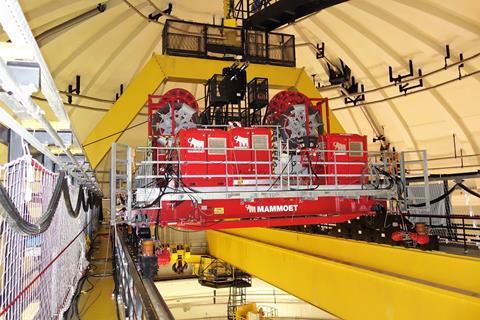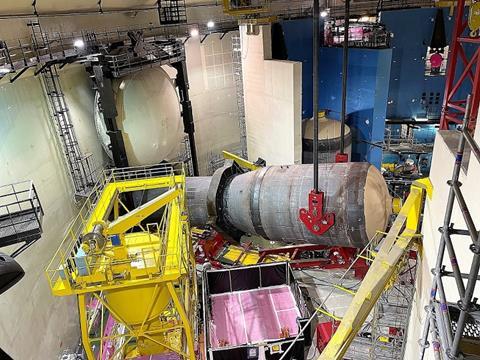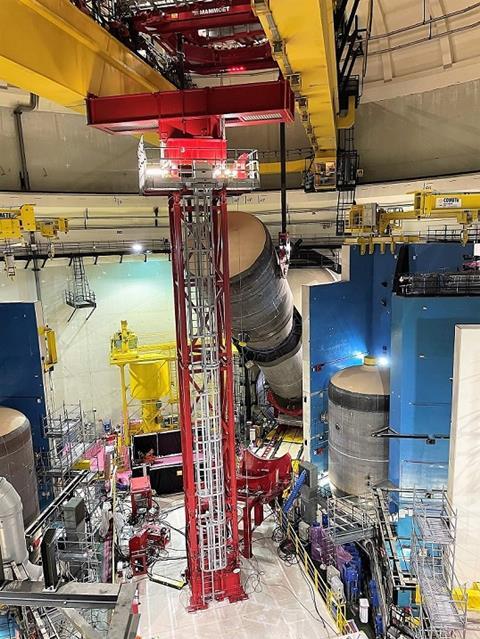Mammoet has removed and replaced four steam generators for Framatome’s 1,300 MW Flamanville FA1 nuclear power plant in France.

Mammoet said that there are few more challenging environments to carry out large-scale maintenance and engineering work than inside a nuclear reactor building. These facilities, which can be decades old, were often designed and constructed with little regard given to the removal of their large and heavy internal components.
These activities need to be carefully documented, in compliance with stringent regulations and standards – submitted in advance, approved and followed to the letter. Failing to do so in a careful and measured way can result in considerable penalties and significant safety risks.
Mammoet said the main challenge was to safely remove the generators in one piece, owing to possible contamination. Removing in one piece also meant a shorter downtime for the power plant. Each generator measured 25 m long, 6.5 m wide, and weighed 520 tonnes.
Mammoet designed a method to safely lift each of steam generators from their respective cubicles; carefully rotate and manoeuvre each unit into a position so that they could be skidded outside the reactor building for decommissioning. The steps were reversed for the installation of the replacement steam generators.
The main piece of equipment Mammoet uses for servicing and replacing parts inside a nuclear reactor building is the polar crane. However, because the steam generators could not be lifted by the polar crane alone, a specialist set of handling equipment had to be produced.
Olivier Vanesse, nuclear activities manager and project director, Mammoet France, said: “The lifting and tailing operation for 1,300 MW nuclear units is very complex. This is due to the fact that each steam generator weighs 520 tonnes, and this is more than the capacity of the polar crane, which has been designed for the placing of each steam generator in two parts at the construction stage. Therefore, you need to use a support in the middle of the polar crane to ensure that during the tailing process it has enough capacity - constraints and deflections-wise.”

As there was no existing specialist handling equipment capable of executing the move, Mammoet devised a specialist lifting solution that comprised of four parts: a lifting trolley, installed on the polar crane, used for lifting and tailing the steam generators; a supporting mast to reinforce the centre of the polar crane; a device for down-ending and tailing the steam generators; and the saddles and skidding tracks used to manoeuvre the generators in and out of the reactor building.
For perspective, the tolerances of space to perform the moves and lifts fell within hundreds of millimetres.
As part of the preparation stages, Mammoet produced a 3D computer-rendered model of the inside of the reactor building. The scans enabled engineers to conduct investigations during site walk downs, to determine tolerances, to develop the design of the equipment, and to plan execution procedures.
“The 3D scans were really useful to us and very accurate. We had scans, as well as high-resolution photos, and were able to make virtual visits to take measurements and see the equipment going inside the reactor building. It was really interesting for us to have this tool at our disposal,” said Vanesse.
The data gathered would inform the project’s site execution studies, which covered everything from the operating procedures and traceability of each step of the project, to the modifications of the polar cranes to ensure that their operation remained in accordance with French regulations. This raised levels of safety across the entire operation, as the work was rehearsed hundreds of times before any equipment ever went to site.
The project was led by a combination of Mammoet experts from France and from Mammoet’s main engineering offices in Schiedam, the Netherlands. The project lasted five years between approach and execution. Mammoet has removed and replaced four steam generators for Framatome’s 1,300 MW Flamanville FA1 nuclear power plant in France.

















